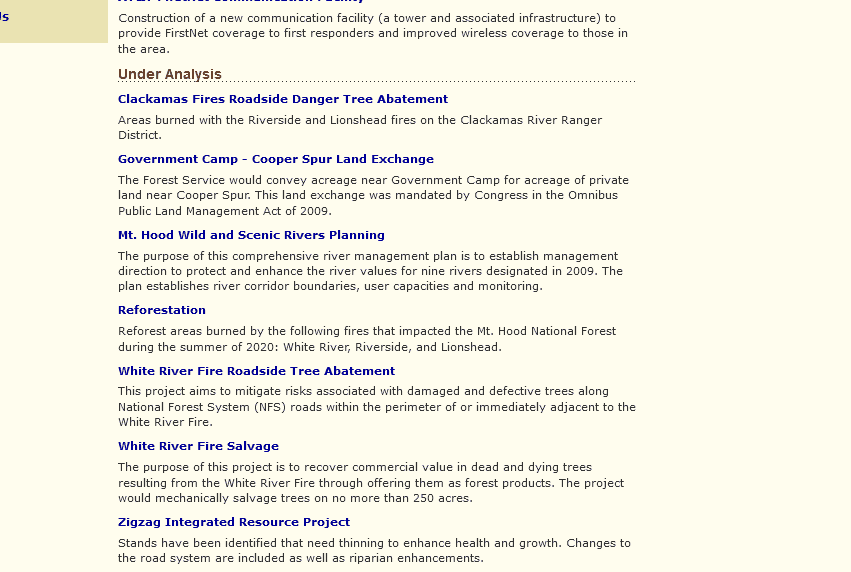Previously Steve posted this story from OPB that mostly focused on concerns about ODOT’s management of hazard tree removal. There was a link to a letter from a variety of groups which talked about the Forest Service.
There are a number of stories at OPB about ODOT’s efforts and management of hazard tree removal, including hearings with the state legislature.
There was one place in the article in which people agreed:
Law, Till, Ford and Allen all agreed it can take years for burned trees to become hazardous, but the state doesn’t plan to wait that long to see which trees need to be removed.
Andersen said arborists are monitoring trees for a few months to see if they become less hazardous over time but the state is sensitive to the risks involved in leaving potentially hazardous trees standing.
“We wouldn’t monitor for years with safety being the top concern if that tree dies,” he said. “I don’t think anybody wants the unfortunate job of going and telling the family that someone died on the roadway because we were monitoring that tree that inevitably fell during an ice storm.”
But leaving ODOT and going back to “what is the Forest Service doing?”, here’s the Region 6 reply to our questions about roadside salvage.
Last summer’s wildfires burned more than 1.2 million acres across Oregon on federal, state, local, and private lands. In September we stood up a regional Operation Care and Recovery team to coordinate efforts to help our employees, the public and communities impacted, and the lands we manage recover. We have been focused on emergency safety and stabilization actions, including working with ODOT and FEMA to remove dead or fire-weakened hazard trees along roadways and near recreation areas to address safety risks to the public and our employees.
We have been completing this work under emergency response provisions and categorical exclusions.
Below are the links for the danger tree and hazard tree guides. We’re using these along with environmental protection plans and the ODOT protection agreement to guide overall criteria.
- Danger Tree Guide: https://www.fs.usda.gov/Internet/FSE_DOCUMENTS/fseprd512960.pdf
- Hazard Tree Guide: https://www.fs.usda.gov/Internet/FSE_DOCUMENTS/stelprd3799993.pdf
You can find any Forest Service salvage (or other) projects by going to the forest’s webpage, going to land management on the sidebar and then projects.

Thanks for posting that, Sharon.
One thing I haven’t seen mentioned is what those cleared road right of ways will look like in the coming years. Under Oregon law, private and state lands must be replanted and free to grow 6 years after a harvest. In 10 years, observers will see swaths of young green trees.
I think public distrust would be less if the FS had contained itself to ONLY hazardous tree removal in past actions. Unfortunately, hazard trees became only a component of a larger tree removal effort. This situation I witnessed firsthand in my early FS career – the greed exhibited by local leadership influenced me for the rest of my career.
There’s a very fine line between cutting only hazardous trees and doing a ‘sanitation cut’. Usually, the kind of temporary employees hired today have no education about trees and forests. Many hazard trees don’t have all that much value, due to advanced rot.
I worked on one project where there were some actual guidelines contained in the timber sale contract, especially regarding catfaces. Many of those trees were probably not immediate hazards but, the contract said those trees had to go.
The function of roads need to be protected, so that waterbars work, ditched are clear and culverts function. Trying to preserve hazardous trees is a bad idea.
I completely agree, Larry…preserving hazard trees is not in the best interest of public safety, especially adjacent to well-traveled roadways. My lament has to do with the perceived permission slip that some FS personnel think they receive to cut additional supposed “hazard trees” when addressing roadway safety. In the memory I have, a roadway was not even involved, but FS leadership felt a “maximum volume, maximum roads” decision was a better outcome rather than a lighter touch to remove only fire-damaged trees (approx 30% of the area). Yes, that decision had a reasonable rationale, but the decision was litigated, resulting in a loss to the FS. I always wondered what would have occurred if the lighter touch option had been chosen.
In my history, I had a similar situation. A planned, but not prepped. timber sale was burned, and one of our Foresters wanted to continue the project, still taking out some larger green trees, as well as the salvage. That idea had to be shot down, because there is inherent conflict in such a plan.
I worked on another project, which was an insect salvage, roadside hazard tree and blowdown recovery project, all rolled into one. The Temporary workforce was encouraged to be more aggressive in marking hazard trees to be cut (with the incentive that they would have a better chance to be re-hired the next year). Large trees with superficial bole scars were being marked, as well as some fork-topped trees. I’m sure that some red firs with cytosphora were getting marked, too. The project was estimated to produce almost 3 million board feet. The total amount logged turned out to be over 8 million board feet. (Since I was very experienced in such projects, I followed the project’s documentation, instead of one or two Forester’s opinions.)
Wasn’t the Cooper Spur land trade controversial, offering pristine forest land near Government Camp in exchange for less desirable private land near Cooper Spur?
Yes indeed, it was and is controversial. Maybe worth a thread of its own someday….
https://www.oregonlive.com/environment/2021/02/mount-hood-land-swap-achieves-new-milestone-generates-new-controversy.html